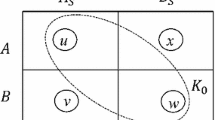Abstract
In this paper we study the problem of making predictions using multiple structural causal models defined by different agents, under the constraint that the prediction satisfies the criterion of counterfactual fairness. Relying on the frameworks of causality, fairness and opinion pooling, we build upon and extend previous work focusing on the qualitative aggregation of causal Bayesian networks and causal models. In order to complement previous qualitative results, we devise a method based on Monte Carlo simulations. This method enables a decision-maker to aggregate the outputs of the causal models provided by different agents while guaranteeing the counterfactual fairness of the result. We demonstrate our approach on a simple, yet illustrative, toy case study.
Access this chapter
Tax calculation will be finalised at checkout
Purchases are for personal use only
Similar content being viewed by others
Notes
- 1.
A Bayesian network (BN) [10] is a structured representations of the joint probability distribution of a set of variables in the form of a directed acyclic graph with associated conditional probability distributions. A causal BN is a BN where all the edges represent causal relations between variables.
- 2.
- 3.
Notice that the decision of considering just the expected value of the pdfs may not be ideal in this case, given the multimodality of these pdfs, as shown in Fig. 5 in the appendix.
- 4.
This precision can be increased by incrementing the number of Monte Carlo samples collected.
References
Alrajeh, D., Chockler, H., Halpern, J.Y.: Combining experts’ causal judgments (2018)
Barabas, C., Dinakar, K., Virza, J.I., Zittrain, J., et al.: Interventions over predictions: reframing the ethical debate for actuarial risk assessment. arXiv preprint arXiv:1712.08238 (2017)
Bradley, R., Dietrich, F., List, C.: Aggregating causal judgments. Philos. Sci. 81(4), 491–515 (2014)
Dietrich, F., List, C., Hájek, A., Hitchcock, C.: Probabilistic Opinion Pooling: Oxford Handbook of Probability and Philosophy. Oxford University Press, Oxford (2016)
Gajane, P.: On formalizing fairness in prediction with machine learning. arXiv preprint arXiv:1710.03184 (2017)
Grossi, D., Pigozzi, G.: Judgment aggregation: a primer. Synth. Lect. Artif. Intell. Mach. Learn. 8(2), 1–151 (2014)
Kusner, M.J., Loftus, J., Russell, C., Silva, R.: Counterfactual fairness. In: Advances in Neural Information Processing Systems, pp. 4069–4079 (2017)
MacKay, D.J.: Information Theory, Inference and Learning Algorithms. Cambridge University Press, Cambridge (2003)
Pearl, J.: Causality. Cambridge University Press, Cambridge (2009)
Pearl, J.: Probabilistic Reasoning in Intelligent Systems: Networks of Plausible Inference. Elsevier, Amsterdam (2014)
Russell, C., Kusner, M.J., Loftus, J., Silva, R.: When worlds collide: integrating different counterfactual assumptions in fairness. In: Advances in Neural Information Processing Systems, pp. 6417–6426 (2017)
Tran, D., Kucukelbir, A., Dieng, A.B., Rudolph, M., Liang, D., Blei, D.M.: Edward: a library for probabilistic modeling, inference, and criticism. arXiv preprint arXiv:1610.09787 (2016)
Zennaro, F.M., Ivanovska, M.: Pooling of causal models under counterfactual fairness via causal judgement aggregation. ICML/IJCAI/AAMAS Workshop on Machine Learning for Causal Inference, Counterfactual Prediction, and Autonomous Action. arXiv preprint arXiv:1805.09866 (2018)
Zliobaite, I.: A survey on measuring indirect discrimination in machine learning. arXiv preprint arXiv:1511.00148 (2015)
Author information
Authors and Affiliations
Corresponding author
Editor information
Editors and Affiliations
Appendices
Appendix A: Algorithms


Appendix B: Figures
Histogram and probability distribution function (computed via kernel density estimation) of \(P(\hat{Y})\) in the model provided by Alice and Bob. The x-axis reports the domain of the outcome of the predictor \(\hat{Y}\); the left y-axis reports the number of samples used to compute the histogram, while the right y-axis reports the normalized values used to compute the pdf.
Histogram and probability distribution function (computed via kernel density estimation) of \(P(\hat{Y}\vert Dpt= CS , Mrk=0.8, Cvr=0.4)\) in the model provided by Alice and Bob. The x-axis reports the domain of the outcome of the predictor \(\hat{Y}\); the left y-axis reports the number of samples used to compute the histogram, while the right y-axis reports the normalized values used to compute the pdf.
Rights and permissions
Copyright information
© 2019 Springer Nature Switzerland AG
About this paper
Cite this paper
Zennaro, F.M., Ivanovska, M. (2019). Counterfactually Fair Prediction Using Multiple Causal Models. In: Slavkovik, M. (eds) Multi-Agent Systems. EUMAS 2018. Lecture Notes in Computer Science(), vol 11450. Springer, Cham. https://doi.org/10.1007/978-3-030-14174-5_17
Download citation
DOI: https://doi.org/10.1007/978-3-030-14174-5_17
Published:
Publisher Name: Springer, Cham
Print ISBN: 978-3-030-14173-8
Online ISBN: 978-3-030-14174-5
eBook Packages: Computer ScienceComputer Science (R0)






